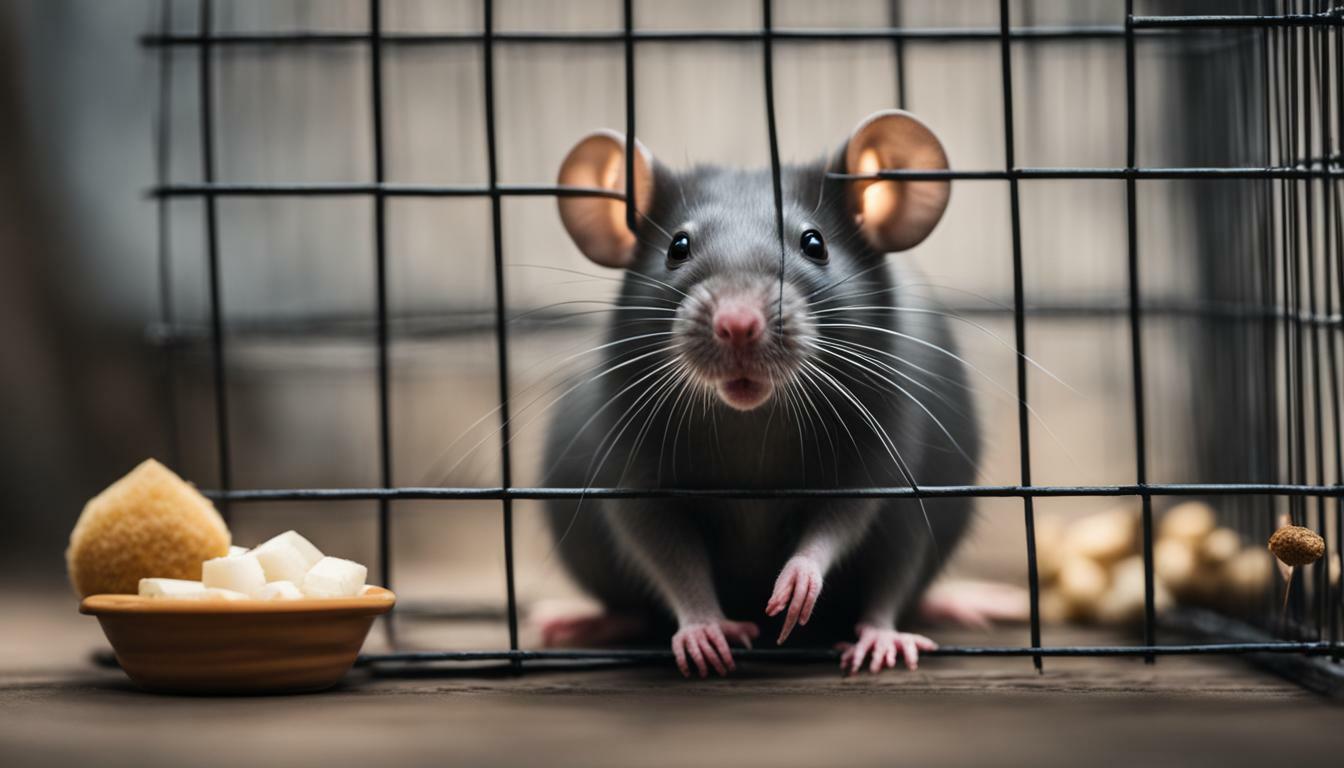If you’re wondering why your rat is swaying from side to side, there could be several reasons behind this behavior. It’s important to understand the causes of rat swaying and how to address any underlying issues for your rat’s well-being.
Key Takeaways:
- Rat swaying behavior can be caused by poor vision or the need to identify potential threats.
- Rats with red or pink eyes often have limited vision in low lighting and bright light, leading them to sway to compensate.
- Blind rats or rats with one eye may sway more frequently as they rely on other senses to navigate their surroundings.
- Swaying behavior in rats can also be a sign of deteriorating vision, especially in older rats or those with underlying health conditions.
- If you notice your rat swaying, consult a vet if their vision is worsening or if there are other concerning symptoms such as excessive porphyrin, bulging eyes, or eye abnormalities.
Common Reasons for Rat Swaying
Swaying behavior in rats can be attributed to several common reasons, including vision problems, attempts to detect threats, and underlying health issues. If you notice your rat swaying from side to side, it is essential to understand the potential causes and address any underlying concerns to ensure your furry friend’s well-being.
One possible explanation for rat swaying is that it helps them compensate for poor vision. Rats with red or pink eyes often have limited vision in low lighting and bright light, causing them to sway as a way to pick up shapes and movements they may not be able to see clearly. This behavior is their way of adapting to their environment and making the most of their visual abilities.
Another reason for rat swaying is their attempt to identify potential threats when they cannot see clearly. Rats that are blind in one eye or have lost an eye may engage in this behavior more frequently as they rely on their other senses to navigate their surroundings. Swaying helps them gather information about their surroundings and stay alert to any potential dangers.
If your rat has recently developed swaying behavior, it could be a sign of deteriorating vision, especially if it is older or has underlying health conditions. It is vital to observe any other accompanying symptoms such as excessive porphyrin (red tears/snot), bulging eyes, cuts or scrapes on the eye, or an eye that appears white or blue. Consulting a vet is crucial in such cases to ensure an accurate diagnosis and appropriate treatment.
| Common Reasons for Rat Swaying | SEO Relevant Keywords |
|---|---|
| Poor vision in rats | rat vision problems, rats with red or pink eyes, limited vision in rats |
| Attempts to detect threats | blind rats, rats with one eye, rats with no eye, rat swaying behavior |
| Underlying health issues | rat balance problems, rat neurological issues, rat health concerns |
- Monitor your rat’s behavior regularly, especially if it displays swaying behavior.
- Consult a vet if you notice any changes in your rat’s vision or other symptoms.
- Create a comfortable environment for your rat, ensuring it has appropriate lighting and visual aids if needed.
- Maintain a healthy diet for your rat, as proper nutrition can support overall well-being.
Swaying for Better Vision
Rats with red or pink eyes may sway from side to side to compensate for their limited vision, particularly in low lighting and bright light conditions. This behavior allows them to pick up on shapes and movements that they may not be able to see clearly otherwise.
This swaying motion helps rats with red or pink eyes improve their visual perception and navigate their surroundings more effectively. It is important to note that rats with red or pink eyes often have reduced visual acuity in both dimly lit and brightly lit environments. Their eyes are more sensitive to light, making it difficult for them to see clearly in these conditions.
Rats rely heavily on their vision to gather information about their environment, so swaying can be an instinctual response to compensate for their limited visual capabilities. By moving from side to side, rats with red or pink eyes can enhance their field of vision, enabling them to detect potential threats or find points of interest in their surroundings.
| Condition | Description |
|---|---|
| Low Lighting | Rats with red or pink eyes struggle to see clearly in dimly lit environments, leading to increased swaying behavior to compensate for their limited vision. |
| Bright Light | Exposure to bright light can cause discomfort for rats with red or pink eyes, further impairing their vision. Swaying helps them adjust their visual focus and gather more information about their surroundings. |
If your rat has red or pink eyes and exhibits swaying behavior, it is likely a natural response to their visual limitations. However, it is always recommended to observe your rat’s overall well-being and consult a vet if you have any concerns about their health or if you notice any changes in their behavior.
Identifying Potential Threats
Rats that are blind in one eye or have no eyes may sway from side to side to help them identify potential threats they cannot visually detect. This behavior is their way of compensating for their lack of vision and relying on their other senses. When a rat cannot see clearly, it becomes essential for them to use movement to gather information about their surroundings.
“Blind rats rely heavily on their sense of hearing and smell to navigate their environment,” says Dr. Animalia, a veterinarian specializing in small animals. “By swaying back and forth, they can detect changes in the air currents, vibrations, and sounds that could indicate the presence of a predator or an object in their path.”
Rats with only one functioning eye may also exhibit swaying behavior as they try to compensate for their limited depth perception. The swaying allows them to gather a better understanding of their surroundings and judge distances more accurately. It’s their way of adapting to their visual impairment to ensure their safety.
| Symptoms of potential vision loss in rats: |
|---|
| Excessive porphyrin (red tears/snot) |
| Bulging eyes |
| Cuts or scrapes on the eye |
| An eye that appears white or blue |
“If you observe any of these symptoms in your rat, it is crucial to seek veterinary advice,” advises Dr. Animalia. “A veterinarian can conduct a thorough examination to determine if there are underlying health conditions contributing to the swaying behavior and provide appropriate treatment.”
Remember, if your rat is swaying from side to side, it is essential to monitor their behavior closely and consult a vet if you notice any changes in their vision or accompanying symptoms. Your vet will be able to diagnose the underlying cause of the swaying behavior and guide you on the best course of action to ensure your rat’s well-being.
Vision Loss in Rats
If your rat starts swaying from side to side, especially if it is older or has underlying health conditions, it could be an indication of vision loss. Rats may engage in this behavior as they try to compensate for their deteriorating vision, relying on movement and swaying to better navigate their surroundings.
Rats with red or pink eyes are more prone to vision deterioration, particularly in low lighting and bright light. Swaying becomes a valuable tool for these rats to pick up on shapes and movements that they may not be able to see clearly.
| Signs of Vision Loss in Rats |
|---|
| Excessive porphyrin (red tears/snot) |
| Bulging eyes |
| Cuts or scrapes on the eye |
| An eye that appears white or blue |
If you notice any of these symptoms along with the swaying behavior, it is crucial to consult a vet. They can assess your rat’s vision and provide appropriate guidance and treatment options.
Tips for Managing Rat Vision Loss
- Create a safe environment for your rat by removing any potential hazards or obstacles.
- Provide your rat with a comfortable and familiar space, ensuring they can easily navigate their surroundings.
- Consider using visual aids, such as contrasting colors or patterns on the cage or toys, to help your rat better distinguish their surroundings.
- Regularly monitor their overall health and schedule check-ups with a vet to address any underlying health conditions contributing to vision loss.
Remember, if your rat is swaying from side to side, it is essential to take their behavior seriously and seek professional veterinary care. By understanding the causes and addressing any vision loss, you can help improve your rat’s quality of life and overall well-being.
When to Consult a Vet
It is vital to consult a veterinarian if your rat’s swaying behavior is accompanied by vision deterioration, excessive porphyrin, or other eye-related symptoms. Swaying behavior in rats can be an indication of underlying health concerns, especially if it is sudden or accompanied by other signs of illness. By seeking professional advice, you can ensure that your rat receives the necessary diagnosis and treatment.
If you notice your rat’s vision deteriorating, such as if it consistently bumps into objects or appears disoriented, it is crucial to consult a vet. Loss of vision can be caused by various factors, including age-related degeneration or underlying health conditions. Your vet will be able to assess the rat’s overall health and provide appropriate recommendations for managing its vision loss.
Excessive porphyrin production in rats can also be a cause for concern. Porphyrin is a red pigment found in tears and nasal secretions, and its presence can indicate respiratory issues or underlying health problems. If your rat’s swaying behavior is accompanied by excessive porphyrin around the eyes, nose, or mouth, it is essential to have it examined by a vet to determine the underlying cause and provide appropriate treatment.
Remember, your rat’s well-being is your priority as a pet owner. Regular veterinary check-ups and open communication with your vet are essential for monitoring your rat’s health and identifying any potential issues. If you have any concerns about your rat’s swaying behavior or notice any other signs of illness, do not hesitate to reach out to your vet for professional guidance.
Monitoring Your Rat’s Behavior
To ensure your rat’s well-being, it is important to monitor its swaying behavior and take appropriate steps to manage any underlying issues. Keeping a close eye on your rat’s behavior can help you identify any changes and address them promptly. Here are some tips for monitoring your rat’s behavior:
- Observe their swaying frequency: Take note of how often your rat engages in swaying behavior. If you notice an increase in frequency or duration, it may indicate a change in their health or vision.
- Watch for other accompanying symptoms: Pay attention to any other symptoms that may be present alongside the swaying behavior. These can include excessive porphyrin (red tears/snot), bulging eyes, cuts or scrapes on the eye, or an eye that appears white or blue.
- Create a comfortable environment: Ensure that your rat’s living space is comfortable and conducive to their well-being. Provide ample bedding, toys for mental stimulation, and a balanced diet to support their overall health.
- Consult a vet: If you have concerns about your rat’s swaying behavior or notice any concerning symptoms, it is important to seek professional veterinary advice. A vet can provide a proper diagnosis and recommend appropriate treatment options.
Tracking your rat’s behavior
One effective way to monitor your rat’s behavior is to keep a behavior log. Create a table to record the date, time, and duration of each swaying episode, as well as any accompanying symptoms you observe. This log can provide valuable information to share with your vet and help track any patterns or changes over time.
| Date | Time | Duration of Swaying | Accompanying Symptoms |
|---|---|---|---|
| November 1, 2022 | 9:00 AM | 5 minutes | Excessive porphyrin |
| November 2, 2022 | 6:30 PM | 2 minutes | Bulging eye |
| November 3, 2022 | 12:00 PM | 10 minutes | Excessive porphyrin, white/blue eye |
“Keeping a behavior log can help you identify any patterns or changes in your rat’s swaying behavior.”
By monitoring your rat’s behavior closely and seeking proper veterinary care when needed, you can ensure their well-being and address any underlying issues that may be causing the swaying behavior. Remember, early detection and intervention are crucial for your rat’s overall health and quality of life.
Treatment Options for Rat Swaying
If your rat’s swaying behavior is concerning, it is recommended to consult a veterinarian who can determine the appropriate treatment based on the underlying cause. Treatment options for rat swaying will vary depending on the specific issue affecting your rat’s balance and vision. A vet will perform a thorough examination and may recommend further diagnostic tests to identify the root cause of the swaying behavior.
Once the cause is determined, the vet may suggest interventions such as medication, environmental adjustments, or dietary changes. In some cases, treating the underlying health condition or addressing vision impairments can help alleviate the swaying behavior. For example, if the swaying is due to poor vision, the vet may prescribe medications to improve eye health or recommend visual aids to assist your rat in navigating its surroundings.
In more severe cases, where the swaying behavior is a result of neurological issues or compromised balance, the vet may recommend physical therapy or rehabilitation exercises to help your rat regain its sense of stability. These exercises can improve coordination and strengthen the muscles used for balance, ultimately reducing the frequency or severity of the swaying behavior.
| Treatment Approaches | Examples |
|---|---|
| Medication | Prescription drugs to address underlying health conditions or improve eye health. |
| Environmental Adjustments | Modifying the rat’s cage or living environment to enhance safety and support their balance. |
| Dietary Changes | Adjusting the rat’s diet to ensure they are receiving appropriate nutrition for optimal health. |
| Physical Therapy | Rehabilitation exercises to improve coordination and strengthen balance-related muscles. |
“The appropriate treatment for your rat’s swaying behavior will depend on the underlying cause. It is crucial to work closely with a vet to develop a tailored treatment plan that addresses your rat’s specific needs.”
Regular follow-up visits with the vet will be necessary to monitor your rat’s progress and make any necessary adjustments to the treatment plan. It is important to follow the vet’s instructions carefully and provide proper care to ensure the best possible outcome for your rat.
To support your rat’s overall health, consider maintaining a clean and stimulating environment, providing a balanced diet, and offering plenty of opportunities for exercise and mental stimulation. Regular check-ups and veterinary care are essential to catch any potential health concerns early on and address them promptly.
Tips for Rat Owners
As a rat owner, there are steps you can take to support your rat’s overall health and well-being, especially if it is exhibiting swaying behavior. It’s important to provide a comfortable and stimulating environment for your pet, ensuring that it has everything it needs to thrive.
First and foremost, pay attention to your rat’s diet. A well-balanced and nutritious diet is crucial for its health. Make sure to provide a variety of fresh fruits and vegetables, high-quality rat pellets, and occasional treats. Consult with a veterinarian to determine the best diet for your rat’s specific needs.
In addition to a proper diet, maintaining a clean and spacious living space is essential. Rats are highly intelligent and active animals that require mental and physical stimulation. Provide plenty of toys, tunnels, and climbing structures to keep your rat engaged and entertained. Regularly clean their enclosure to prevent the buildup of bacteria and odors.
Regular veterinary check-ups are also important. A qualified veterinarian will be able to assess your rat’s health, provide necessary vaccinations, and address any concerns you may have. Remember to discuss your rat’s swaying behavior with the vet to rule out any underlying health issues.
Summary
- Ensure your rat has a nutritious and balanced diet.
- Provide a clean and stimulating living environment.
- Schedule regular veterinary check-ups.
| Rat Care Tips | Managing Rat Swaying | Rat Health Concerns |
|---|---|---|
| Proper diet | Comfortable environment | Veterinary check-ups |
| Stimulation and enrichment | Mental and physical exercise | Addressing underlying health issues |
| Clean living space | Regular cleaning | Vaccinations and preventive care |
Conclusion
If your rat is swaying from side to side, it’s essential to consider the potential causes and ensure they receive appropriate care to maintain their health and well-being. The behavior can be a result of various factors, including poor vision, the need to compensate for limited eyesight, or identifying potential threats when visual cues are absent.
Rats with red or pink eyes often have limited vision in low lighting and bright light, leading them to sway in an attempt to enhance their sight. Additionally, rats that are blind in one eye or have lost an eye may engage in swaying behavior more frequently as a way to adapt to their surroundings.
If you notice your rat suddenly developing swaying behavior, especially if it is older or has underlying health conditions, it could be an indication of vision deterioration. It is crucial to seek veterinary advice in such cases, particularly if there are accompanying symptoms like excessive porphyrin, bulging eyes, cuts or scrapes on the eye, or an eye that appears white or blue.
While rats naturally have poor vision, they do not strain to see their environment without a reason. If your rat is swaying from side to side, it is best to monitor its behavior and consult a vet if necessary. With proper attention and care, you can help ensure your rat’s overall well-being and address any underlying health concerns they may have.
FAQ
Why is my rat swaying from side to side?
If you notice your rat swaying from side to side, it could be due to a few reasons. One possible explanation is that the rat is trying to get a better view of its surroundings, especially if it has poor vision. This behavior is more common in rats with red or pink eyes, as they have limited vision in low lighting and bright light. Swaying helps them pick up on shapes and movements that they may not be able to see clearly. Another reason for swaying could be that the rat is trying to identify any potential threats that it cannot see. Rats who are blind in one eye or have lost an eye may also engage in this behavior frequently. If your rat has recently developed this swaying behavior, it could be a sign that it is losing its vision, especially if it is older or has underlying health conditions. It is essential to consult a vet if your rat’s vision is deteriorating or if you notice any other symptoms such as excessive porphyrin (red tears/snot), bulging eyes, cuts or scrapes on the eye, or an eye that appears white or blue. While rats naturally have poor vision, they do not strain to see their environment without a reason. Overall, if your rat is swaying from side to side, it is best to monitor its behavior and consult a vet if necessary.
What are the common reasons for rat swaying?
The most common reasons for rat swaying include trying to compensate for poor vision and identifying potential threats. Rats with red or pink eyes may sway more often due to their limited vision in low lighting and bright light. Additionally, rats who are blind in one eye or have lost an eye may engage in this behavior frequently as they rely on other senses to navigate their surroundings.
Can rat swaying indicate vision loss?
Yes, if a rat suddenly develops swaying behavior, especially if it is older or has underlying health conditions, it may be a sign of deteriorating vision. It is essential to consult a vet if your rat’s vision is deteriorating or if you notice any other symptoms such as excessive porphyrin (red tears/snot), bulging eyes, cuts or scrapes on the eye, or an eye that appears white or blue.
When should I consult a vet about my rat’s swaying behavior?
It is important to seek veterinary advice if your rat’s vision deteriorates or if you notice any other concerning symptoms such as excessive porphyrin, bulging eyes, or eye abnormalities. Consulting a vet will help determine the underlying cause and appropriate treatment options for your rat’s swaying behavior.




